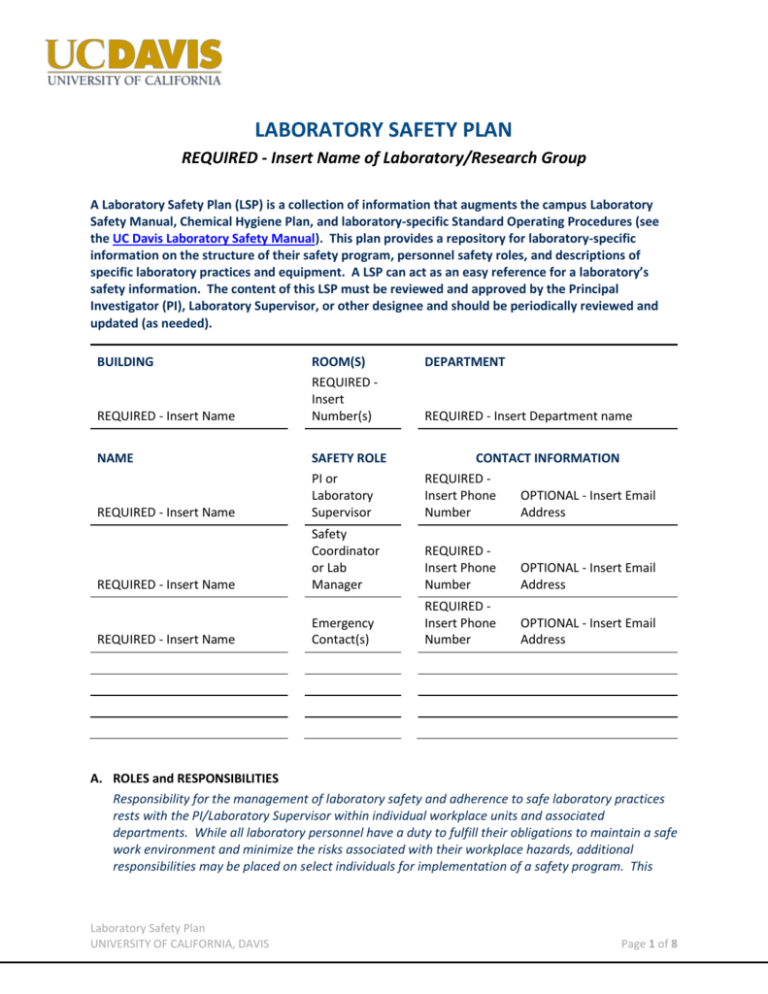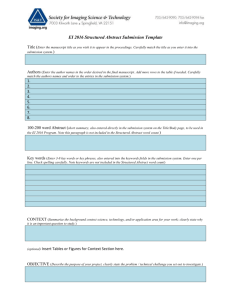LSP Template - UC Davis Safety Services
advertisement

LABORATORY SAFETY PLAN REQUIRED - Insert Name of Laboratory/Research Group A Laboratory Safety Plan (LSP) is a collection of information that augments the campus Laboratory Safety Manual, Chemical Hygiene Plan, and laboratory-specific Standard Operating Procedures (see the UC Davis Laboratory Safety Manual). This plan provides a repository for laboratory-specific information on the structure of their safety program, personnel safety roles, and descriptions of specific laboratory practices and equipment. A LSP can act as an easy reference for a laboratory’s safety information. The content of this LSP must be reviewed and approved by the Principal Investigator (PI), Laboratory Supervisor, or other designee and should be periodically reviewed and updated (as needed). BUILDING ROOM(S) REQUIRED Insert Number(s) DEPARTMENT REQUIRED - Insert Name SAFETY ROLE PI or Laboratory Supervisor CONTACT INFORMATION REQUIRED Insert Phone OPTIONAL - Insert Email Number Address REQUIRED - Insert Name Safety Coordinator or Lab Manager REQUIRED Insert Phone Number OPTIONAL - Insert Email Address Emergency Contact(s) REQUIRED Insert Phone Number OPTIONAL - Insert Email Address REQUIRED - Insert Name NAME REQUIRED - Insert Name REQUIRED - Insert Department name A. ROLES and RESPONSIBILITIES Responsibility for the management of laboratory safety and adherence to safe laboratory practices rests with the PI/Laboratory Supervisor within individual workplace units and associated departments. While all laboratory personnel have a duty to fulfill their obligations to maintain a safe work environment and minimize the risks associated with their workplace hazards, additional responsibilities may be placed on select individuals for implementation of a safety program. This Laboratory Safety Plan UNIVERSITY OF CALIFORNIA, DAVIS Page 1 of 8 section defines the roles and responsibilities for this LSP [see the Rights and Responsibilities Section in the UC Davis Laboratory Safety Manual (UCD LSM) for reference]. REQUIRED - Insert descriptions of the laboratory safety roles. Each role description should include the associated chemical/laboratory safety responsibilities. This shall include any PI/LabSupervisor responsibilities being formally delegated. OPTIONAL - LSP REVISION - Define the frequency of review/revision to the LSP and identify the responsible party for the review. Any revisions must be approved by the PI/Lab Supervisor, and all personnel trained on the revisions. OPTIONAL - LEAVE/ABSENCE POLICY - Describe who is responsible when designated responsible lab personnel are on leave or otherwise absent. This can also include the communication structure for extended absences. REQUIRED - NEAR-MISS REPORTING - Describe the lab-specific process for reporting, documenting, and discussing near-misses. Documentation must be maintained for at least five years and be readily available. B. HAZARD DETERMINATIONS AND HAZARD IDENTIFICATION Information about hazardous substances and activities, the associated risks, and the measures to mitigate those risks is required for all work areas including laboratories. Specific hazards within laboratories should be identified using the University of California Laboratory Hazard Assessment Tool (LHAT). All laboratory hazards must be identified by the LHAT or other methods. REQUIRED IF APPLICABLE - If other methods were used for hazard assessment, insert a brief description of those methods. For laboratories within the scope of this LSP, hazard assessment documents are maintained (Click to choose an item). REQUIRED - CHEMICAL LABELING REQUIREMENTS - Describe as applicable the chemical labeling format and requirements for this laboratory. Definitions of used acronyms or abbreviations should be included as an attachment/appendix. REQUIRED IF APPLICABLE - SAMPLE LABELING REQUIREMENTS - Describe the sample identification/labeling system and requirements for this laboratory. This may include any archive structure, hazard statements, responsible parties, etc. REQUIRED IF APPLICABLE - ANIMAL HANDLING - Unique requirements including AALAS and AAALAC requirements and guidance apply to research animal handling. May be included as an attachment/appendix. OPTIONAL - HAZARD & OTHER POSTINGS - Describe postings/signage to address specific or unique laboratory hazards, including work spaces. Postings/signage should be defined in SOPs, but those requirements may be consolidated here. OPTIONAL - PYROPHORICS - Should already be addressed in SOPs, but may want to add detail (e.g., specific locations of extinguishing media within the laboratory on a schematic, responsible person for periodic inspections, etc.). Laboratory Safety Plan UNIVERSITY OF CALIFORNIA, DAVIS Page 2 of 8 OPTIONAL - PEROXIDE FORMERS - Describe lab management procedures of time-sensitive peroxide-forming, chemicals (e.g., expiration date protocol, responsible persons for checking/testing containers, max storage quantities, etc.). Alternatively can be a SOP. OPTIONAL - ERGONOMICS - Lab-specific factors and/or activities may need ergonomic assessment/consultation to ensure safe practices. Fill in as applicable. C. ENGINEERING CONTROLS Engineering controls are an effective means of protecting workers and are the preferred methods for personnel protection. Examples of engineering controls include, but are not limited to, general room ventilation, chemical fume hoods, glove boxes, biological safety cabinets, downdraft tables, “elephant trunks” (or “snorkels”), gas cabinets, and ventilated balance enclosures. REQUIRED - ENGINEERING CONTROLS - Consolidate SOP requirements and provide more detail in this LSP. REQUIRED IF APPLICABLE - If there are unique, lab-specific engineering controls not already described in the UCD LSM, provide written procedures for those engineering controls. Consult the Chemial Hygiene Officer for assistance. D. ADMINISTRATIVE CONTROLS Administrative controls consist of policies and procedures to reduce or prevent exposures to laboratory hazards. These controls are generally not as reliable as engineering controls in that the user has to carefully follow the appropriate procedures and must be fully trained in order to do so. Training must be documented REQUIRED - WORKING ALONE - Labs without a dedicated working alone SOP must specify what is and what is not acceptable, restrictions, notifications, etc. Consolidate all working alone requirements into the LSP or attach your Working Alone SOP. REQUIRED IF APPLICABLE - CLEAN ROOM CRITERIA - If this LSP applies to a clean room, specify requirements related to maintenance of clean room criteria, including proper gowning/PPE, equipment entry and exit, maintenance, pressure differentials, etc. OPTIONAL - ADMINISTRATIVE CONTROLS - Should already be addressed in SOPs, however may want to consolidate or add detail in this LSP. Fill in as applicable/desired. OPTIONAL - UNACCEPTABLE OR RESTRICTED ACTIVITIES - Should already be addressed in SOPs, however may want to consolidate/summarize in LSP including restrictions and quantities. Fill in as applicable. OPTIONAL - COMPUTER WORKSTATION REQUIREMENTS OR RESTRICTIONS - Describe any restrictions of using computer workstations within laboratory areas, particularly in shared use areas. Define any glove/chemical-free areas. OPTIONAL - DATA SECURITY - Describe lab-specific procedures and protocols to ensure reliable data storage and theft protection. Laboratory Safety Plan UNIVERSITY OF CALIFORNIA, DAVIS Page 3 of 8 OPTIONAL - REGULATED/DESIGNATED AREAS - Should already be addressed in SOPs or Use Authorizations, but may need supplemental information or summary in your LSP. Fill in as applicable. E. PERSONAL PROTECTIVE EQUIPMENT (PPE) Personal protective equipment serves as a researcher’s last line of defense against chemical exposures. PPE augments the minimum attire required to enter a laboratory or storage area containing hazardous chemicals. REQUIRED - PPE - Describe PPE requirements identified by hazard assessment and/or specified in SOPs. PPE requirements in the certified LHAT assessment may be inserted or the certified assessment attached for reference. REQUIRED IF APPLICABLE - MINIMUM ATTIRE EXCEPTION - If your lab has been granted an exception to the PPE Policy for minimum atttire, you must document in detail that exception within your LSP. F. USE AUTHORIZATIONS Laboratory operations that use lasers, radioactive materials, radiation producing machines, controlled substances, or include biological hazards must follow additional guidelines outlined in the associated hazard-specific UC Davis Safety Manuals and Programs (e.g., Radiation Safety Manual, Controlled Substance Program, Laser Safety Manual, Biosafety Program, etc.) and obtain Use Authorizations prior to work with these materials. REQUIRED IF APPLICABLE - RADIATION USE AUTHORIZATION- If the lab has an RUA, provide the RUA# and isotopes. Additional detail can be provided as desired, or the RUA documentation can be included as an attachment/appendix. REQUIRED IF APPLICABLE - CONTROLLED SUBSTANCE AUTHORIZATION- If the lab has a Controlled Substance provide the approved drug(s) and location of the secured log. Additional detail can be provided as desired or included as an attachment/appendix. REQUIRED IF APPLICABLE - LASER USE - If the lab has a registered laser, provide the registration number and laser class. Additional detail can be provided as desired or included as an attachment/appendix. REQUIRED IF APPLICABLE - BIOLOGICAL USE AUTHORIZATION- If the lab has a BUA, provide the BUA# and medical waste location (if applicable). Additional detail can be provided as desired, or the BUA documentation can be included as an attachment/appendix. G. CHEMICAL SECURITY Implementation of a laboratory-specific security plan can help to minimize potential malicious actions. OPTIONAL - CHEMICAL PROCUREMENT - Describe lab-specific chemical procurement process, personnel allowed to order chemicals, approval requirements, restrictions, shipping requirements/restrictions, etc. Laboratory Safety Plan UNIVERSITY OF CALIFORNIA, DAVIS Page 4 of 8 OPTIONAL - CHEMICAL INVENTORY - Describe lab-specific chemical inventory process, particularly if a separate chemical inventory is kept outside of the campus CIS. Describe inventory responsibilites and frequencies. OPTIONAL - CHEMICAL STORAGE - Describe lab-specific chemical storage details such as designated locations and segregation. Should already be addressed in SOPs but may want to consolidate and summarize in this LSP. OPTIONAL - CHEMICAL ACCESS RESTRICTIONS - Describe lab-specific restrictions on chemical access, methods to prevent chemical diversion, etc. H. EQUIPMENT AND INSTRUMENTATION Specific equipment and instrumentation have unique hazards that must be understood and addressed by administrative controls, engineering controls, and/or by the use of personal protective equipment. Specialized procedures may be required prior to using or performing work on equipment or instrumentation. REQUIRED - SHUTDOWN PROCEDURES - Describe lab-specific equipment shutdown procedures for planned utility outages. REQUIRED IF APPLICABLE - LOCKOUT-TAGOUT (LOTO)- Describe lab-specific equipment that have LOTO requirements. OPTIONAL - SPECIALIZED EQUIPMENT- Specialized equipment (such as gloveboxes, isolators, etc.) may need written operational procedures to optimize the function of this equipment and delineate important safety features. OPTIONAL - EQUIPMENT/TOOLS - Describe or reference lab-specific equipment and tool safety procedures. Examples include lab equipment, shop tools, walk-in freezer, furnace, etc. OPTIONAL - MACHINE GUARDING - Describe lab-specific guarding on machines or tools. OPTIONAL - ROTARY EVAPORATORS- Describe or reference procedures for use of rotary evaporators in lab to address acceptable use locations (e.g. in or out of a chemical hood), and safe use precautions. Can be stand alone SOP. Fill in as appropriate. I. EMERGENCY AND SPILL PROCEDURES Laboratory emergencies may result from a variety of factors, including: serious injuries, fires and explosions, spills and exposures, and natural disasters. All laboratory-specific factors must be addressed for proper response to emergencies, as well as any scheduled utility outages OPTIONAL - EMERGENCY SAFETY EQUIPMENT - Describe or list lab-specific equipment, locations, etc. OPTIONAL - EMERGENCY PLANS - Describe lab-specific emergency plans above and beyond the Departmental Emergency Action Plan and posted egress route and contact names and numbers as applicable. J. INSPECTIONS AND COMPLIANCE Laboratory Safety Plan UNIVERSITY OF CALIFORNIA, DAVIS Page 5 of 8 Laboratory inspections are required on a routine basis, at least annually. While inspections are a snapshot in time and cannot identify every accident-causing condition, they do provide important information on the overall operation of a particular laboratory. Laboratory personnel may use the EH&S self-inspection checklist, or use an alternate inspection checklist at the discretion and preference of laboratory personnel that best meets the needs of the laboratory. REQUIRED IF APPLICABLE - LAB INSPECTION FORM - If a lab-specific inspection form has been developed to address unique circumstances, equipment, processes, etc., please describe or attach that form. Follow-up and documentation related to any identified corrective actions is very important. Inspection documentation for recent inspections and follow-up actions for laboratories within the scope of this LSP must be maintained for at least five years and be readily available. REQUIRED - Indicate how and where the documentation is maintained K. TRAINING Effective training is critical to facilitate a safe and healthy work environment and prevent laboratory accidents. All laboratory personnel must complete the online UC Laboratory Safety Fundamentals training course before beginning work in a laboratory. Additionally, before being granted unescorted access to a laboratory, personnel must complete and document site-specific safety orientation and training. Guidance on materials that need to be covered in the site-specific safety orientation and training is provided in the Site-Specific Safety Orientation & Training Checklist for New Laboratory Personnel, which includes documentation of training on the campus Chemical Hygiene Plan (CHP) and this LSP. Equivalent checklists and documentation are also acceptable. All laboratory personnel shall have annual refresher training to include review of the Department IIPP and EAP, the LSP and any additional laboratory-specific safety information at the discretion of the PI/Lab Manager or designated laboratory safety person. All training records for laboratory personnel shall be maintained in perpetuity. OPTIONAL - TRAINING - Describe lab-specific training requirements and due dates. Attached or reference any lab-specific training checklists and documentation as applicable. L. HAZARDOUS WASTE Each laboratory must comply with the campus Hazardous Waste Management Program requirements and all applicable regulations. REQUIRED IF APPLICABLE - ENVIRONMENTAL - Describe any lab-specific drain disposal processes and protocols. OPTIONAL - HAZARDOUS WASTE - Summarize lab-specific hazardous waste requirements including details such as waste container locations, frequency of disposal, labeling, etc. M. HAZARD ASSESSMENTS AND CHEMICAL EXPOSURE MONITORING (HACEM) Cal/OSHA requires that all employers “measure an employee’s exposure to any substance regulated by a standard which requires monitoring if there is reason to believe that exposure levels for that substance may exceed the action level (or in the absence of an action level, the exposure limit).” Repeated monitoring may be appropriate for different reasons. If you have questions on existing Laboratory Safety Plan UNIVERSITY OF CALIFORNIA, DAVIS Page 6 of 8 HACEM results or have activities that may be a candidate for HACEM please contact heathandsafety@ucdavis.edu. OPTIONAL - HACEM - If desired, compile or otherwise summarize industrial hygiene monitoring results specific to your labs or representative results. May provide a good training tool for new lab personnel. Laboratory Safety Plan UNIVERSITY OF CALIFORNIA, DAVIS Page 7 of 8 TEMPLATE REVISION HISTORY Version 1.0 Date Approved 4/14/2015 Author Chris Jakober Revision Notes: New template LAB-SPECIFIC REVISION HISTORY Version Date Approved Laboratory Safety Plan UNIVERSITY OF CALIFORNIA, DAVIS Author Revision Notes: Page 8 of 8





